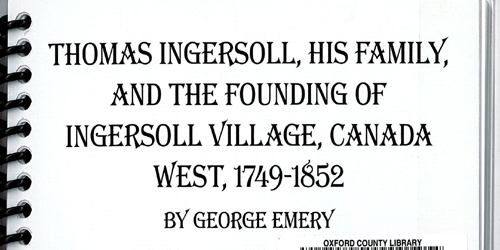the history of the town of ingersoll
Thomas Ingersoll - A Brief Biography
By Harry Whitwell
(excerpt from Ingersoll Our Heritage, 1978)
Governor Simcoe invited Thomas Ingersoll to settle himself and his family and 40 other families in Ontario (Upper Canada). Thomas Ingersoll and his family had emigrated to Salem, Massachusetts, U.S.A. from England in 1629. He accepted the invitation even though he had not fought with the British in the war of the Revolution. After talking to his friends and many other people, he arranged for his part of the agreement of forty families. Then, in 1795, he signed the contract to settle and start a town along with a Mr. Loomis and several others.
The majority of the settlers that Thomas Ingersoll brought took up lots of 200 acres of the land at 6 pence per acre in the townships surrounding the village. These lots were surveyed in 1799 and 1800 and deeds were issued to the owners.
Major Ingersoll was a very aggressive man and eventually spent most of his fortune in the interests of the settlement. He had planned to bring about 1,000 settlers from New York, U.S.A. who were not U.E.L.'s [United Empire Loyalists]. To this the British disagreed. Governor Simcoe had been recalled to England and the new administration would not honour such a contract.
In 1806, Thomas Ingersoll became so discouraged that he left the village he had founded and moved to a home near Port Credit, where he died in 1812.
The following is a list of the forty settlers who came to Upper Canada with Major Ingersoll, and the date of registration of their grant of land:
Samuel Canfield, 1798
Thomas Dexter, 1798
Noah Sawyer, 1802
Samuel Hall, 1802
Lucius Morgan, 1802
John Sherman, 1806
David Curtis, 1802
Daniel Ingersoll, 1802
Joshua Crossman, 1805
M. Parsons, 1806
David Sabine, 1802
David Thompson, 1803
John Clark, 1804
Samuel Maek, 1804
Rueben Thrall, 1804
Rueben Forrester, 1804
Lanadar Barnes, 1805
Charles Whiting, 1805
Elisha Harstling, 1798
Eleazer Scott, 1798
James Hopkins, 1798
Ichobod Hall, 1801
Thomas Ingersoll, 1802
Elisha Otis, 1802
Robert Spellman, 1802
James Piper, 1805
Samuel Burdick, 1805
David Salsey, 1802
John Gordon, 1802
Ebenezer Cook, 1803
Nicholis Brink, 1802
James Sage, 1804
James Forrester, 1804
Elisha Haskin, 1805
Montgomery Austin, 1805
Ebenezer Whiting, 1805
Thomas Lee, 1805
William Maynard, 1804
E. Loomis, 1798
Charles Parkhurst, 1805
However, before he left the village, Thomas Ingersoll and some friends with the help of Chief Joseph Brant (chief of the Six Nations) and some of his colleagues, set off through the heavy bush to explore the lands west of the Grand River.
Western Ontario was at that time a dense forest with no roads. Paths only had been made by the Indigenous people on their trips from Detroit to Ancaster. (Ancaster in the early 1800's was of greater importance than Hamilton.)
After many hardships, they chose the heavily forested area at the branch of the river called "The La Tranche" (Thames River where our town bridge is now located). The Indigeous name for the river is AS-KUM-E-SE-BE (Antlers like An Elk). They started a settlement near the river trail at a point where the native peoples, for centuries in their journeying, had left the river and directed their course south-east in a straight line toward Brantford. The earliest records tell of Indian tribes of the Chippewas, Mohawks, and some Eries found an encampment near the banks of "The Riviere La Tranche."
T. Ingersoll then went back to Massachusetts for his family, arriving back in Oxford on the Thames in 1795. This same year he cut down the first tree in the county to make the first log house in Ingersoll which is located on the east side of Thames (where P.T. Walker and Don Douglas stores are now located). [Fire in 1991 destroyed these stores. In their place is a gazebo and small park.]
The Indigeous peoples and the settlers found that the soil around the river point, though very well wooded, to be rich and productive. The land was rolling and fertile with an expanse of marsh that was well watered with springs. The surveyor, General Chewett, called this land the most valuable tract of land in the province.
The Upper [Canada] Gazette of September 13, 1799, related to the heroic struggles of the early settlers and the sacrifices of Thomas Ingersoll at a period where every settler was under every possible discouragement common to the new country. Thomas Ingersoll pursued his plans of improving the Oxford township by sponsoring other families at his own expense. He continued to offer lots of 200 acres at 6 pence per acre.
All the settlers were very aware of the importance of roads, and in one year, at the expense of Mr. Ingersoll, they cut and bridged a road from Burford through 25 miles of dense bush. This road was about 10 feet wide. They also cleared and made possible the road leading from Governor Road to the river "La Tranche," in order to promote and enlarge the settlement of Oxford-on-the-Thames and open up the surrounding country for future dairy farms. This road also help with the lumber supply.
Mr. Ingersoll's settlement of Oxford-on-the-Thames was eventually in the centre of the best industrial, agricultural, and cheese and dairy business. Twenty miles to the west was to be London, which at this time was only a fork in the river, and to the east (five miles) was Beachville and east another five miles was Woodstock with population of about 1500.
Thomas Ingersoll was married three times. His first wife, Elizabeth Dewey, had four children: Laura (who was to become famous), Elizabeth, Myra, Abigail. His second wife, Mercy Smith had no children. His third wife, Sarah Whiting, had seven children: Charles, Charlotte, Appy, Thomas, Samuel, James, and then Sarah who was born after they left Oxford.
Text from Ingersoll Our Heritage, 1978 by Harry Whitwell, republished with the kind permission of Mrs. Harry Whitwell
A Genealogy of the Ingersoll family in America, 1629-1925
A complete family history of Thomas Ingersoll, founder of the town of Ingersoll, Ontario
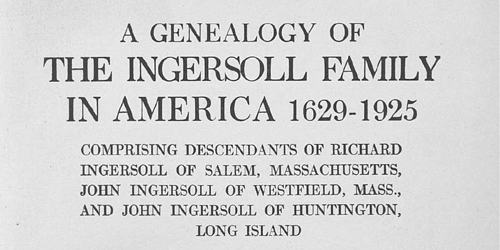
Index to: No Smiling Path by Catharine B. McEwen
Explore stories of area pioneer families. Lookups available at localhistory@ocl.net
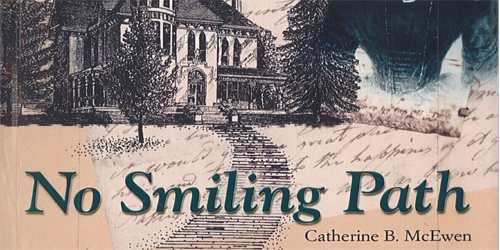
Ingersoll Family in St. Marys
Written by Mary Smith and published by the St. Marys Independent, this article explores the Ingersoll Family and their influence on the town.
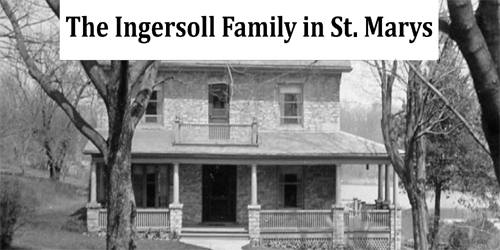
Ingersoll family scrapbook
Given to his son by James M. Ingersoll - Leslie Hall Ingersoll 1894-1972 compiled this scrapbook documenting his Ingersoll ancestors.

Laura Ingersoll Secord clippings
A searchable collection of excerpts, newspaper clippings, related to Laura Secord
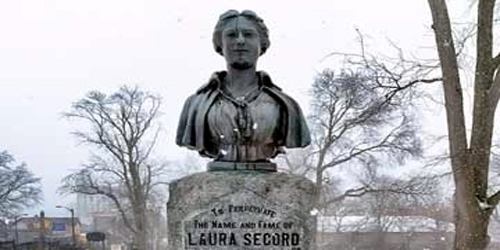
Laura Ingersoll Secord, 1775-1868
Though Laura Secord never lived in Ingersoll, she was a daughter of town founder Thomas Ingersoll. Explore this excerpt from a 1913 book by Emma A. Currie.
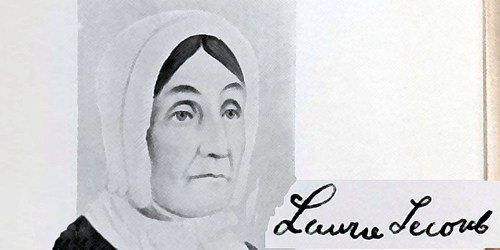
The Ingersolls of Hampshire
by Charles Stedman Ripley. Documenting the lineage of John Ingersoll, forefather of Thomas Ingersoll, founder of Ingersoll, Ontario
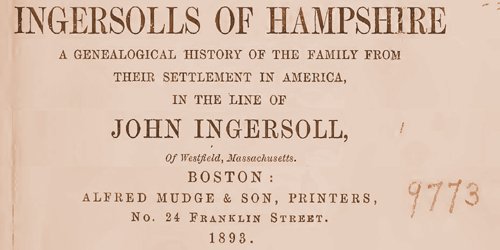
The Story of Laura Secord, 1813
by S. A. Curzon. Published by the Lundy's Land Historical Society in 1891.
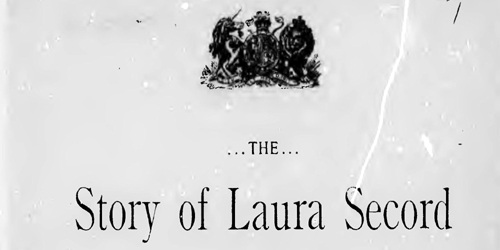
Thomas Ingersoll, his family, and the founding of Ingersoll village, Canada West, 1749-1852
by George Emery. This work describes the early life and family history of Thomas Ingersoll in the United States and how he came to found a village in Upper Canada.
